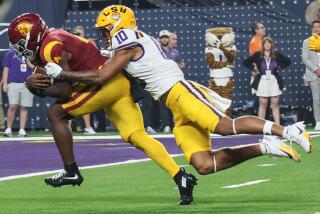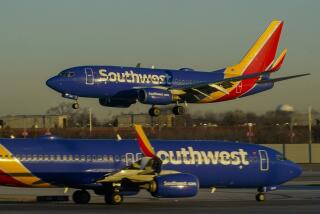In-Flight Live TV Is Tricky Issue
- Share via
For years, airlines controlled what passengers saw on their cabin screens, editing out scenes of graphic violence or sex, and banning movies altogether if they showed airline crashes.
But now, with three U.S. airlines offering live television feeds and on-board Internet access expected to be available within a year, passengers can see anything they want -- even news coverage of an event in which they might be taking part.
After the drama aboard JetBlue Flight 292 unfolded live on television Wednesday, executives of Denver-based Frontier Airlines, which like JetBlue shows DirectTV on its flights, began to rethink their policy of keeping on the feed until the pilot decides to shut it down. As a result, the company probably would implement a new policy that calls for turning off the service during in-flight emergencies, Frontier spokesman Joe Hodas said.
“If I’m panicked by what I see on TV, I’m not as likely to pay attention to the flight attendant telling me to put head between legs and prepare for landing -- or whatever they might be telling me,” he said. “I’m not as apt to follow [directions] if I’m hysterical from what I’m watching on TV.”
But a spokeswoman for JetBlue, whose passengers even watched the planes crashing into New York’s World Trade Center on Sept. 11, 2001, said the company would not change its policy of allowing pilots to decide whether to turn off the TV.
Company officials have long chosen not to censor television feeds and believe that, on balance, it’s better to have information available to passengers, spokeswoman Fiona Morrison said.
“We had quite a few planes in the air on Sept. 11,” Morrison said. “People on the planes could see the coverage through CNN, and we found that the majority of people appreciated getting that information.”
On Wednesday’s flight, she said, the pilot and crew turned off the feed only when they needed to communicate directly with the passengers.
Robert J. Thompson, director of the Center for the Study of Popular Television at Syracuse University, said the question of what to do about live feeds during an airline emergency points to a key tension between “the rhetoric of the cockpit,” which stresses calm and safety, and the “rhetoric of journalism,” which often relies on hyperbole.
“It’s a big ethical issue,” Thompson said, with the need for security balanced against the unfairness of cutting passengers off from information that, in a real emergency, “could well be the last information those people get.”
Matthew Ash, a Gardena man who was on Flight 292, said some of the material being broadcast was welcome -- such as details on what was wrong with the plane. But on the whole, he said, the images served more to scare people than to calm them.
“It definitely added to the anxiety,” said Ash, a youth minister with the Western Diocese of the Armenian Church of North America. He said the pilot and crew provided important information that seemed more reliable than the TV coverage.
The availability of live television has been a big selling point for JetBlue, whose planes have a small screen embedded in the back of each seat, allowing every passenger to watch any of 36 satellite channels.
Live television and Internet access are appealing to airlines, because they can offer these perks relatively cheaply while saving the space and weight used for the bulky video equipment used to show movies, said Henry Harteveldt, a San Francisco-based airline industry analyst with Forrester Research.
“There’s money to be made and money to be saved” by having live TV on planes, he said.
Since JetBlue paved the way in 2000, two other domestic airlines -- Frontier and Song, a division of Delta Airlines -- followed suit, as have Canadian airline WestJet and Singapore Airlines, Harteveldt said.
American Airlines does not offer live television, but a spokesman said Wednesday that the company was considering offering wireless Internet.
Bob Marsocci, spokesman for DirectTV, said the move to include live TV -- whether satellite or via the Internet -- is part of a trend in American society to make television more mobile.
“We’re seeing more and more people take their TV with them,” he said. “People want to have immediate access to information.”
Jon Russell, safety coordinator for the Airline Pilots Assn., said that as a passenger, he would want the information that might come from live coverage.
But he said sensational or inaccurate reporting could make things difficult for a pilot by misleading passengers about what was really going on. And that, Russell said, means the pilot and crew would have one more thing to deal with.
“You have the emergency, the cabin crew preparing for an evacuation -- you don’t know how much time you’re going to be allotted before you land,” Russell said, “and then you have a bunch of passengers starting to question what’s going on. They’re going on information that they’re seeing on TV that is contradictory to what you were trying to accomplish, and that could be a problem.”
Marty Kaplan, associate dean of the USC Annenberg School for Communication and director of the Norman Lear Center, said the experience of watching oneself in an unfolding television drama was not surprising in an age of reality TV, when people enfold themselves in soundtracks from their iPods and understand their lives through movies and television.
But in real life, he said, it might be better for the passengers to get their information from the pilot and crew.
“The greater good in that case is a calm plane and a pilot and crew with no unnecessary obstacles to being in charge and following a plan,” Kaplan said.
*
Times staff writer Scott Collins contributed to this report.
More to Read
Sign up for Essential California
The most important California stories and recommendations in your inbox every morning.
You may occasionally receive promotional content from the Los Angeles Times.













